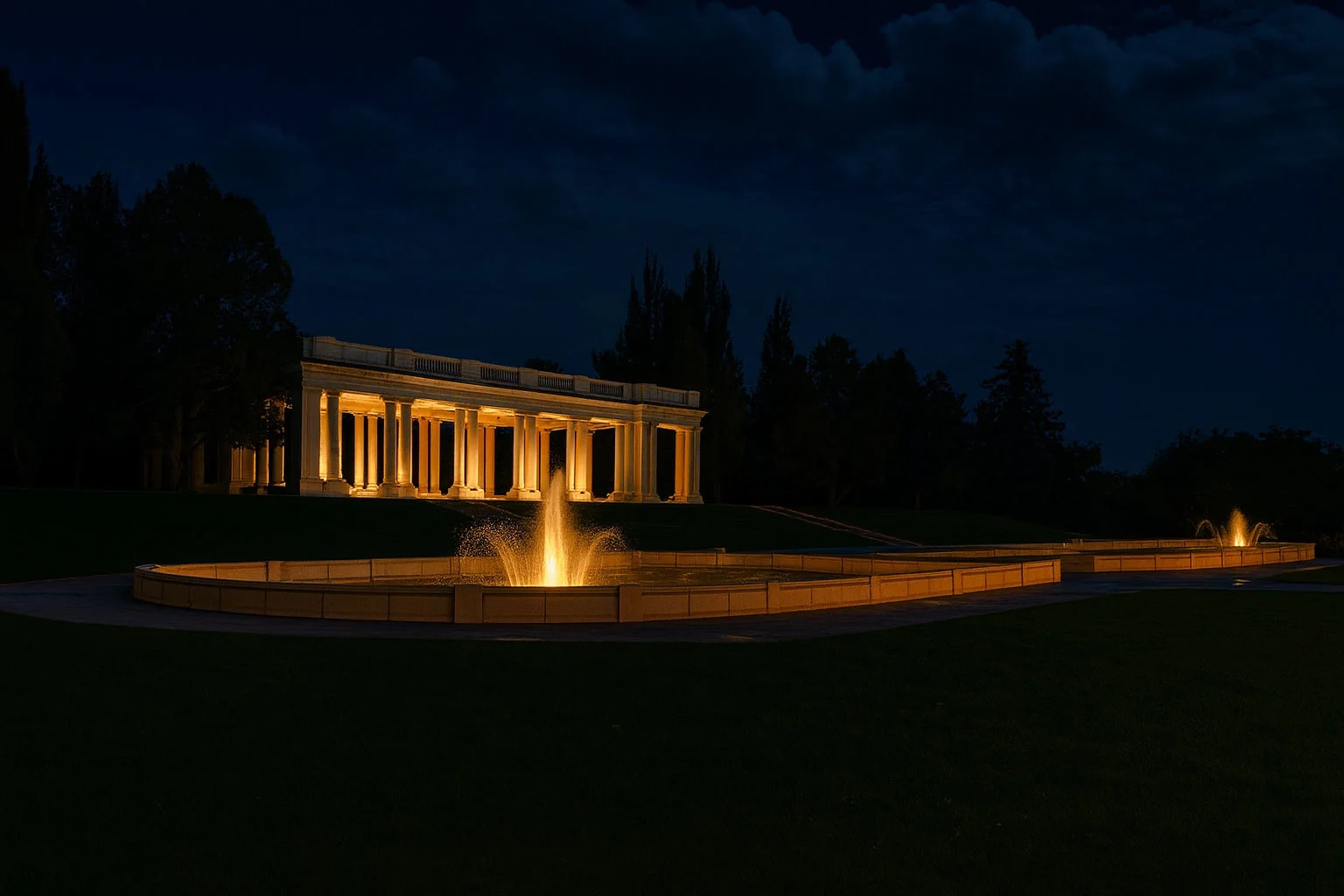Walk through Cheesman Park on a sunny afternoon, and you'll see joggers, picnickers, and families enjoying Denver's beautiful weather. But as night falls, the park transforms. Shadows move where no one walks. Voices whisper from empty spaces. And those who know the park's dark history understand why—you're walking on the desecrated graves of thousands.
Fast Facts
- Originally Mount Prospect Cemetery (1858-1890s)
- Approximately 5,000+ bodies still remain beneath the park
- Site of one of Denver's most horrific body removal scandals
- Known for extremely active paranormal phenomena
- One of Colorado's most haunted locations
Is Cheesman Park Haunted?
Cheesman Park isn't just haunted—it's a paranormal hotspot where the veil between the living and dead seems dangerously thin. The thousands of spirits whose graves were disturbed and bodies desecrated have never rested peacefully, and they make their anger known to anyone who visits after dark.
The Desecrated Cemetery
To understand Cheesman Park's hauntings, you must know its horrific history. The land was originally established as Mount Prospect Cemetery in 1858, Denver's first official graveyard. For decades, it served as the final resting place for pioneers, children, paupers, and those who died from disease, violence, and the harsh realities of frontier life.
By the 1890s, the cemetery had fallen into disrepair and was considered an eyesore in what had become a fashionable neighborhood. The city decided to convert the land into a park, and families were given notice to relocate their deceased loved ones. But here's where the nightmare began—thousands of graves belonged to people with no living relatives, the poor, criminals, and those who died in the 1860s from a devastating smallpox epidemic.
The city hired undertaker E.P. McGovern to remove the remaining bodies—a job that should have been conducted with dignity and respect. Instead, McGovern saw it as an opportunity for profit, and what followed became one of Denver's most shameful scandals.
The Body-Chopping Undertaker
E.P. McGovern was paid $1.90 per body he removed and reburied elsewhere. The city provided child-sized coffins (measuring only 3 feet 6 inches long) to save money, assuming most remains would be fragmentary after years in the ground.
But McGovern discovered something horrifying would make him more money—many bodies had been preserved by the dry Colorado climate and didn't fit in the small coffins. His solution was monstrous: he began chopping the bodies into pieces to fit them into the undersized caskets.
Workers at the site were horrified, reporting McGovern and his crew using saws and axes to dismember corpses, sometimes hacking a single body into multiple parts to fill several small coffins—thereby claiming payment for multiple removals. Body parts were left scattered across the ground. Bones were carelessly tossed aside. Graves were opened and then abandoned when McGovern decided they contained 'too much work.'
Newspapers of the day reported the gruesome scene: body parts littering the grounds, the smell of death hanging over the area, and witnesses seeing workers literally chopping up corpses. The scandal erupted in March 1893, with the Rocky Mountain News publishing graphic accounts of the desecration. McGovern's contract was terminated, but by then, the damage was done.
The worst part? The city, eager to move forward with park construction, simply stopped the removal process. Approximately 5,000 bodies were never relocated. The city built Cheesman Park directly on top of them, and there they remain to this day—disturbed, desecrated, and furious.
The Restless Dead
Given the horrific desecration of their graves, it's no surprise that Cheesman Park is intensely haunted. Visitors report paranormal activity so frequent and disturbing that many refuse to enter the park after dark.
The most commonly reported phenomenon is the appearance of shadow figures—dark, human-shaped forms that move across the grass, dart between trees, and approach visitors before vanishing. Unlike typical shadows, these figures move independently of any light source and often appear in broad daylight. Witnesses describe them as aggressive, sometimes rushing toward people before dissipating.
Many visitors report being physically touched by unseen forces—pushes, shoves, tugs on clothing, and even the sensation of invisible hands grabbing their arms or legs. Some have reported being forcefully pushed to the ground by entities they couldn't see. These physical encounters are often accompanied by sudden temperature drops and overwhelming feelings of rage or despair.
The sound of voices is frequently reported throughout the park, particularly near the pavilion (built directly over the cemetery's central section). People hear whispered conversations, crying, screaming, and anguished moaning. Some report hearing their names called by unfamiliar voices, only to turn and find no one there.
Dog walkers consistently report their pets refusing to enter certain areas of the park, particularly after dusk. Dogs will bark at empty spaces, cower in fear, or refuse to walk on specific sections of grass—often the areas where cemetery records indicate mass graves were located.
The Ghost Jogger and Phantom Figures
Several specific apparitions have been reported so frequently at Cheesman Park that they've become legendary among paranormal enthusiasts.
The most famous is the 'Ghost Jogger'—a figure of a man in old-fashioned running clothes who appears to be jogging through the park at twilight. Witnesses report seeing him run past them at inhuman speed, sometimes passing right through trees, benches, or other people. When they turn to look back, he's vanished. Some believe this spirit is trapped in a residual haunting, eternally running through a park that didn't exist when he was alive.
A woman in a white dress is frequently seen near the pavilion, standing perfectly still and staring at the ground as if looking at a grave. When approached, she slowly fades away. Some psychics report sensing overwhelming grief from this spirit and believe she may be a mother searching for her child's grave, lost when the cemetery was destroyed.
Numerous witnesses have reported seeing what they describe as a 'funeral procession' moving through the park late at night—a line of translucent figures dressed in Victorian mourning clothes, carrying what appears to be a coffin. The procession moves slowly across the grass, following paths that no longer exist, before fading into nothingness. Some researchers believe this is a residual haunting, a psychic imprint of one of the thousands of funerals that took place when the area was still a cemetery.
The Homes Built on Cemetery Land
The paranormal activity isn't confined to the park itself. Many of the historic homes surrounding Cheesman Park were built on former cemetery land, and their residents report disturbing phenomena.
Homeowners in the area have reported seeing apparitions in their houses and yards, hearing unexplained voices and footsteps, and experiencing poltergeist activity—objects moving, doors slamming, and items disappearing. Some have reported finding human bones in their yards during gardening or construction work, gruesome reminders that bodies still lie beneath the surface.
One infamous case involves a Victorian home on the park's eastern edge where multiple families have reported seeing the apparition of a man in 1800s clothing standing at the foot of beds, staring down at sleeping residents. The figure is described as having a malevolent presence, and several families have moved out citing the haunting as unbearable.
Construction workers renovating homes in the area have reported tools being thrown by invisible forces, the sensation of being watched, and seeing shadow figures in unfinished rooms. Some refuse to work alone in these houses, and there are stories of contractors abandoning jobs mid-project due to the paranormal activity.
Paranormal Investigations and Evidence
Cheesman Park has been investigated by numerous paranormal research teams, and the evidence collected is compelling.
EVP (Electronic Voice Phenomena) sessions conducted in the park have yielded hundreds of recordings of unexplained voices. Some clearly say 'help me,' 'why?,' and 'where am I?'—heartbreaking pleas that seem to come from the disturbed spirits. More disturbing are the angry voices captured, with some EVPs containing threats and demands to leave.
Photographic evidence is abundant. Countless pictures taken in Cheesman Park show unexplained orbs, mists, and shadow figures that weren't visible when the photos were taken. Some images show what appear to be partial human forms—translucent legs, arms, or torsos appearing in otherwise empty areas of the park.
EMF (Electromagnetic Field) detectors consistently show extreme spikes in areas where no electrical sources exist. These readings often correspond with witnesses reporting feelings of being watched or experiencing sudden temperature drops.
Perhaps most compelling are the thermal imaging results. Investigators have captured footage showing human-shaped cold spots moving through the park, with temperatures dropping 20-30 degrees in localized areas. These cold spots often move against the wind and seem to respond to investigators, approaching them or moving away in patterns that suggest intelligence.
The History of Cheesman Park
The land that would become Cheesman Park has a complex and disturbing history that stretches back to Denver's earliest days.
From Cemetery to Park
Mount Prospect Cemetery was established in 1858 on land then far from Denver's populated areas. For over three decades, it served as the final resting place for thousands of Denver residents. The cemetery was divided into sections—some for wealthy families with elaborate monuments, others for paupers who were buried in unmarked graves.
As Denver grew and expanded, the cemetery found itself in the middle of what became a fashionable neighborhood. By the 1890s, prominent citizens demanded the cemetery be removed, calling it unsightly and depressing. The city agreed, planning to convert the land into a park.
The removal process began in 1893, but the McGovern body-chopping scandal brought it to a horrified halt. The city, embarrassed and eager to move forward, simply abandoned the removal effort. Official records claim about 2,000 bodies were relocated, but cemetery records indicate over 7,000 burials took place there. This means at least 5,000 bodies remain beneath the park.
Cheesman Park was officially opened in 1907, named after Denver pioneer Walter Cheesman. The beautiful pavilion, walking paths, and manicured lawns transformed the former cemetery into a popular gathering place—but the dead beneath were never forgotten, and they've made their presence known ever since.
Visiting *Cheesman Park* in Denver
Cheesman Park is a public park located in central Denver, open 24 hours a day. The park is beautiful during the day, but the paranormal activity intensifies after dark, particularly between the hours of 9 PM and 3 AM.
The area around the marble pavilion (which sits directly over the cemetery's central section) is considered the most actively haunted. The trees along the park's eastern edge and the areas nearest the surrounding homes also show high paranormal activity.
If you visit Cheesman Park, particularly at night, be respectful—you're walking on thousands of graves. Many paranormal investigators believe the spirits here are angry because their final resting places were desecrated, and they may not take kindly to those they perceive as trespassing.
Bring a camera, recording device, and EMF detector if you're interested in documenting paranormal activity. But also bring a friend—Cheesman Park is not a place you want to be alone after dark.

Cheesman Park, where thousands of disturbed spirits still rest uneasily beneath the ground
